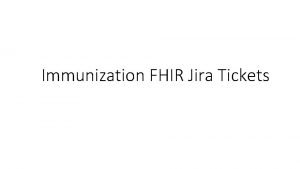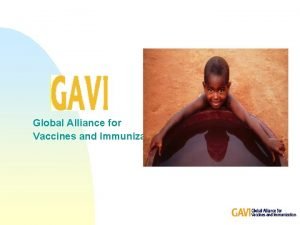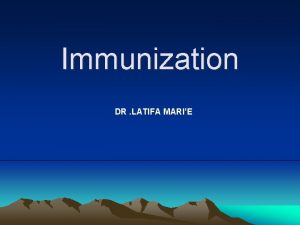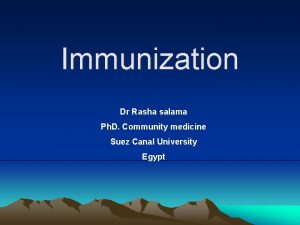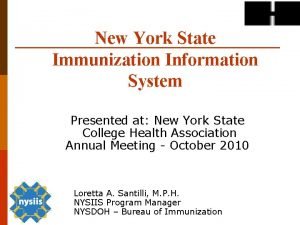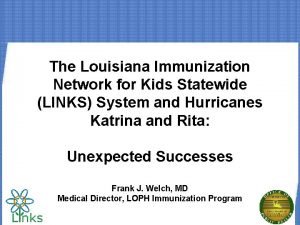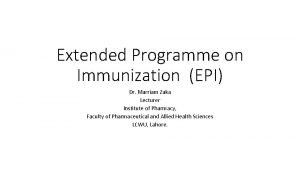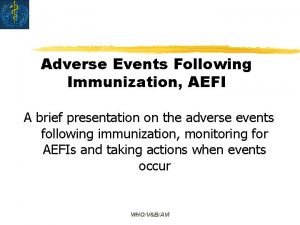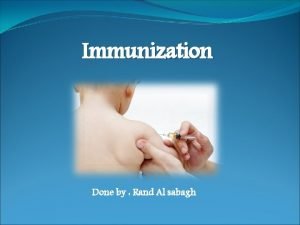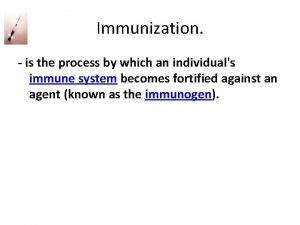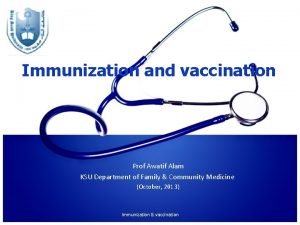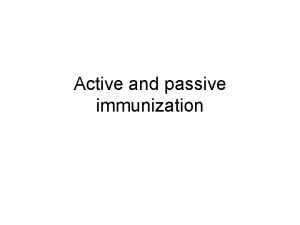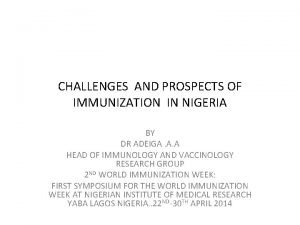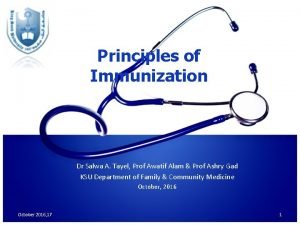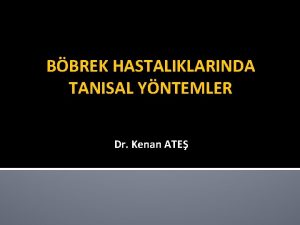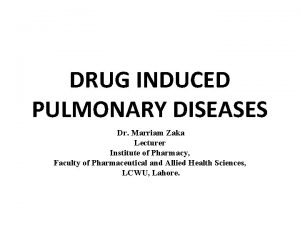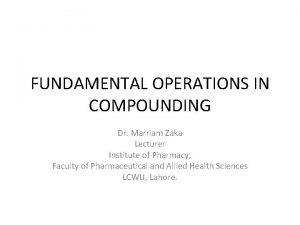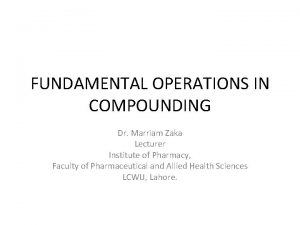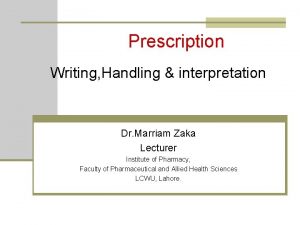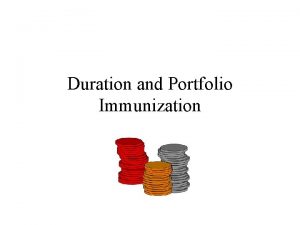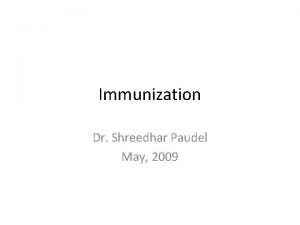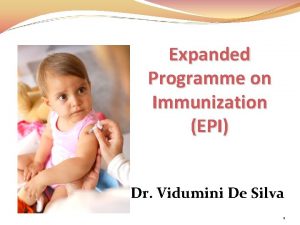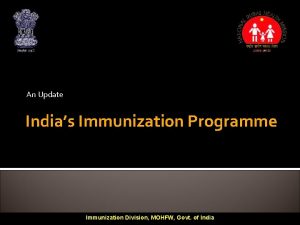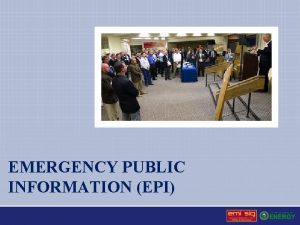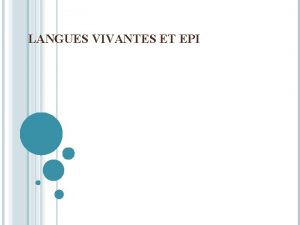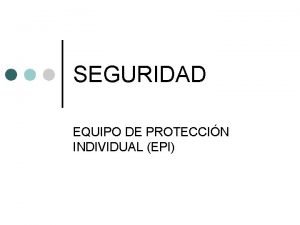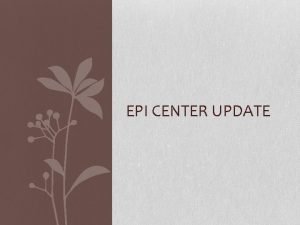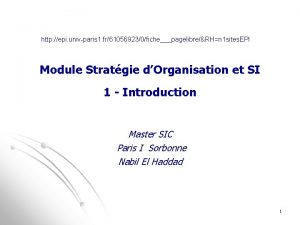Extended Programme on Immunization EPI Dr Marriam Zaka






























- Slides: 30

Extended Programme on Immunization (EPI) Dr. Marriam Zaka Lecturer Institute of Pharmacy, Faculty of Pharmaceutical and Allied Health Sciences LCWU, Lahore.

The Expanded Programme on Immunization (EPI) • is a disease prevention activity aiming at reducing illness, disability and mortality from childhood diseases preventable by immunization. These diseases are referred as 9 EPI target diseases and cause millions of ailments, disabilities & deaths each year. • Poliomyelitis • Neonatal Tetanus • Measles • Diphtheria • Pertussis (Whooping Cough) • Hepatitis-B • Hib Pneumonia • Meningitis • Childhood Tuberculosis

Expanded Program on Immunization • The Expanded Program on Immunization is a World Health Organization program with the goal to make vaccines available to all children. • The World Health Organization (WHO) initiated the Expanded Program on Immunization (EPI) in May 1974 with the objective to vaccinate children throughout the world. • Ten years later, in 1984, the WHO established a standardized vaccination schedule for the original EPI vaccines: Bacillus Calmette. Guérin (BCG), diphtheria-tetanus-pertussis (DTP), oral polio, and measles. Increased knowledge of the immunologic factors of disease led to new vaccines being developed and added to the EPI’s list of recommended vaccines: Hepatitis B (Hep. B), yellow fever in countries endemic for the disease, and Haemophilus influenzae meningitis (Hib) conjugate vaccine in countries with high burden of disease

EPI ; According to Govt. of Punjab : • The diseases are preventable and can be eradicated like Smallpox, as very safe & effective vaccines are available. 27 % of deaths in < 5 years age group are due to vaccine Preventable Diseases. 80% children of world are being protected against childhood TB. • 3 million children & 19. 5 million Child bearing age females are being protected against eight vaccine preventable diseases and tetanus respectively. 1000 deaths in less than 5 year children will daily occur in Pakistan, if EPI is discontinued. • Immunization is one of the most successful and cost effective health interventions. It has eradicated small pox, lowered the global incidence of polio so far by 99% and achieved dramatic reductions in illness, disability and death from diphtheria, tetanus, whooping cough and measles. • It is a world-wide Programme being carried out in all countries assisted by WHO, UNICEF and other donor agencies. The global target of the Programme is to immunize over 95% of infants and child-bearing-age females.

Historical Development of EPI in Pakistan • Pilot Project 1978 • Integrated into regular Health Services 1983 • Accelerated Health Programme (AHP) 1985 • Addition of Vaccine for Hep. B 2002 • Addition of Vaccine for Hib Meningitis & Pneumonia 2008 • Addition of Pneumococcal 2012 • The EPI Programme started in Pakistan in 1978 and is still continuing. New vaccine Pneumococcal is introduced in the EPI immunization Schedule in 2012 and Rota-virus Vaccine is planned in 2013.

Schedule in EPI- Pakistan

The current goals of the EPI in Pakistan are • to ensure full immunization of children under one year of age in every district, • to globally eradicate poliomyelitis, • to reduce maternal and neonatal death to an incidence rate of less than one case per 1, 000 births by 2005, • to cut in half the number of measles-related deaths that occurred in 1999, and • to extend all new vaccine and preventive health interventions to children in all districts in the world.

EPI in Pakistan • The Expanded Program on Immunization (EPI) has been the exclusive provider of public immunization services in Pakistan for the last three decades. However, the country still has a long way to go before it achieves the EPI’s objectives. • This Program aims to reduce infant mortality and morbidity by immunizing children against poliomyelitis, tuberculosis, diphtheria, pertussis, tetanus, measles, hepatitis B, pneumonia, meningitis, rotavirus, and haemophilus influenza type B. • It also vaccinates pregnant women to protect them from tetanus toxoid and their foetuses from neonatal tetanus. • The program was initiated by the World Health Organization and operates with assistance from the Government of Pakistan, the United Nations Children’s Fund (UNICEF), and the Global Alliance for Vaccine and Immunization (GAVI)

EPI in Pakistan • In Pakistan, the Expanded Program on Immunization aims to immunize all children between 0 and 23 months against eight vaccine preventable diseases that include infant tuberculosis, poliomyelitis, diphtheria, pertussis, neonatal tetanus, hepatitis B, Haemophilus influenza type b (Hib), and measles. • Pakistan has had to face multiple challenges over the last decade, including natural and man-made disasters, as well as an unstable macroeconomic situation. The Government of Pakistan (GOP) has made significant effort to provide relief to millions of displaced people affected by these emergencies.

EPI in Pakistan • The challenge for Pakistan is to strengthen the health system and improve performance of the routine EPI coverage from the stagnant low rates that prevail at present, and achieve and maintain high rates of coverage during the supplementary immunization activities for achieving polio eradication. • Amendment 18 to the Constitution of Pakistan was implemented in July 2011, allowing for a devolution of authority from the federal to the provincial level with the elimination of the so-called “Concurrent List, ” an enumeration of approximately forty areas where federal law prevailed, including the health sector, which is now fully devolved to the provinces.

EPI in Pakistan • In the last two decades the EPI program has not achieved the expected reduction of Vaccine Preventable Disease (VPD) burden • Poor capacity of EPI human resources has contributed significantly to its poor performance. • Procurement of vaccines and other required items, cold chain monitoring, and maintenance of equipment within the EPI is poorly managed. • The EPI is under-resourced to achieve expected results • Demand by the communities for immunization services is variable.

Health Delivery Model • Pakistan has an extensive health care–delivery system consisting of a mix of both public and private sectors. • primary health care services are offered through a network of basic health units (BHUs) and sub health centers (5, 310), rural health centers (561), maternal child health centers (879), and dispensaries (4, 794). • Secondary and tertiary care services are provided through tehsil/taluka, district, and teaching hospitals (948). • In 78 districts (more than 50 percent of the districts in Pakistan), the BHUs function as a public-private partnership arrangement managed by civil servants on secondment to rural support organizations (RSOs) under the Peoples Primary Healthcare Initiative (PPHI). • The public sector also provides preventive services through vertical programs, for example, EPI, TB Control Program using DOTS strategy (TB-DOTS),

Health Delivery Model • National Program for Family Planning and Primary Healthcare (commonly called LHWs Program), AIDS Control Program, Malaria Control Program (through Roll-Back Strategy), Nutrition Program, and Reproductive Health Program: (managed fully by the federal level until 2001 and partially until July 2011, since then completely by the provincial level). • There is also a large network of medical practitioners and approximately 12, 000 registered civil society organizations (CSOs) in the country providing a significant proportion of primary health care services.

Immunization Program • The Expanded Program on Immunization (EPI) has existed for nearly thirty years. • The basic objective of the program is to reduce death, disease, and disability due to vaccinepreventable diseases (VPDs), • and to contribute to the strengthening of national health systems and the attainment of Millennium Development Goal 4 (MDG-4). • . Government of Pakistan, Ministry of Health, National Health Policy, (Islamabad, 2001).

Immunization Program • In order to accomplish its two main objectives, the National EPI targeted to achieve 90 per cent routine immunization coverage of all EPI antigens with at least 80 per cent coverage in every district of Pakistan by 2010, and sustained coverage for reaching the Millennium Development Goals 4 and 5 by 2015 • It may be mentioned that MDG 4 targets reduction in child mortality and MDG 5 is to reduce maternal mortality ratio by 2015. • Moreover, the Program aimed to eliminate neonatal tetanus and interrupt polio virus transmission by 2012 and achieve certification by 2014.

Immunization Program • EPI services are provided most exclusively through the public health delivery network through fixed centers and outreach services. The centers are managed by vaccinators with support from lady health workers (LHWs), BHU and other hospital staff; some of the EPI centers in the PPHI-managed basic health units are managed by vaccinators with limited assistance from the BHU staff. • The challenge for Pakistan is to strengthen the health system and improve the performance of the routine EPI coverage from the currently stagnant low rates, while maintaining high rates of coverage in the supplemental immunization activities (SIAs) within the devolved health structure.

Service Delivery Options • Fixed centers versus outreach services • Door-to-door • Campaigns

Why EPI is not successful in Pakistan • The key reasons that EPI has not achieved its targets have been identified in different studies and are summarized here. • Inadequate service delivery, resulting in irregular access and poor service utilization, were found to be the key reasons for this poor performance. • The long distance to EPI centers, unaffordable cost to reach these sites, and unavailability of vaccinators and outreach services were the reasons for 12. 6 percent of mothers’ failing to immunize their children through the routine service. Distance to the health centres was again highlighted in a recent study conducted in 2009 where 30 percent of mothers reported that it was difficult to reach the nearest health facility from their place of residence. • . Government of Pakistan, “Coverage Evaluation Survey 2006. ” (Islamabad, 2007). • . Government of Pakistan, Faisal et al. , “Understanding Barriers to Immunization in Pakistan, ” (Islamabad, 2009).

Why EPI is not successful in Pakistan • Additional reasons from the service provider’s aspect include lack of funds for operational costs for vehicles, repair of vehicles and equipment, travel allowance/daily allowance (TA/DA) for the staff, insufficient vaccination staff and supervisors, insufficient cold chain equipment below the district level, failure to develop micro-plans for the routine immunization program, lack of demand for EPI by BHU staff, and excessive demands by the health sector to respond to the Polio Eradication Initiative. • In addition, comprehensive service delivery is also compromised because of difficulties in reaching internally displaced persons (IDPs), nomads, and those in insecure areas.

Why EPI is not successful in Pakistan • immunization, in Pakistan started to lag behind. Pakistan’s efforts towards immunization were also affected after 2000 on account of war on terror and natural disasters – both of which made coverage more difficult. • All provinces lag behind the terms of their stated goals for newborns and pregnant mothers. Balochistan and hard areas of Khyber Pakhtunkhwa in particular are most challenging for the EPI activities

Why EPI is not successful in Pakistan • The key barriers highlighted in these papers include lack of parents’ awareness hence low population demand for immunization, limited access to immunization services and weak management, social resistance to vaccines by certain population groups, civil conflicts and natural disasters, the devolution of national health ministry, and the inability of the district and provincial governments to tackle it as a national emergency

Why EPI is not successful in Pakistan • The target population for Pakistan’s national immunization program is huge, and millions of doses of vaccine are delivered successfully by government services every year. • None the less, as many as 40 percent of the children below five years remain unimmunized or under-immunized, particularly in the poor and rural sections of the country. There are tremendous challenges to overcome in delivering these services.

Disease-specific issues • Polio: The PEI has not yet been successful in eradicating poliomyelitis virus. The PEI has been well funded and advertised and has claimed everyone’s attention at the expense of other health initiatives including routine immunization. With approximately 120 days a year spent by immunization staff on polio NIDs/SNIDs, the time and effort left for the routine immunization program is grossly inadequate. Furthermore, repeated rounds of NIDs/SNIDs since 1994 have resulted in fatigue of all cadres of staff involved in polio eradication.

Polio • Mismanaged child immunization and the prevalence of polio in certain parts of Pakistan are not only a national emergency but also a threat to the whole world. While global eradication of polio has almost been achieved, • Pakistan is one of the only three countries in the world where this crippling virus still exists. This is despite the fact that efforts to eradicate polio and other fatal diseases began almost four decades ago, much earlier than its other neighboring countries that already have a polio-free certification today. Serious efforts to eradicate polio and other fatal diseases in Pakistan were initiated in 1978 under The Expanded Program on Immunization (EPI).

Disease-specific issues • Measles is an important cause of death and disability among children in Pakistan. Approximately 2. 1 million children are infected with measles annually, resulting in approximately 21, 000 deaths from complications. With routine measles vaccine coverage of only 50 percent or so, an ever-increasing number of infants are not reached. As an emergency response to this situation, the Government of Pakistan (GOP) partnered with global efforts to reduce measles morbidity and mortality: The GOP decided to give a second opportunity for vaccination against measles to all susceptible children aged 9 months to less than 13 years who would be vaccinated through this campaign, irrespective of previous vaccination status and measles infection. This program demanded additional immunization staff time. Furthermore, it should be noted that campaigns of this nature to immunize wider age groups do not necessarily protect the primary target age group of under-ones.

logistics • Logistics for EPI includes the provision of • (a) vaccines, diluents, injection equipment, and safety boxes; and • (b) cold chain equipment covering items like cold rooms, refrigerators, ice-lined refrigerators (ILRs), cold boxes, carriers, and ice.

Enhancing the Performance of EPI • Interprovincial Coordination • Planning • Service provision options • Performance-based incentive and extra payments • Campaigns • Supervision and Monitoring and evaluation • Finance

conclusion • It concludes that specific targeting is required whereby immunization dropouts should be brought back on time to EPI centers. • Based on data indicating new and old disease prone areas, existing EPI centers should be relocated and the government may consider creating new centers at locations that can reduce transportation costs and travel time, which in turn can also result in fewer immunization dropouts

conclusion • The challenge for Pakistan is to improve the stagnant low rates of routine immunization coverage while achieving and maintaining high rates of coverage in the Polio campaigns. • Cognizant of the challenge, the Government of Pakistan (GOP) requested the World Bank to conduct a review of the EPI and offer recommendations to improve the program’s performance.

conclusion • Pakistan does not have unlimited resources to meet these vast demands; hence there is competition for the resources that are available. • Traditionally, at the federal and provincial levels, Pakistan’s immunization program managers have actively engaged in the budget process to ensure that appropriate funds were allocated at each administrative level to immunization as part of the health budget. • If needed, they have also sought ways to attract additional funds to the program from extra budgetary sources such as bilateral donors as well as from domestic sources within the country including civil society. • In addition, they have engaged with other program managers to explore ways of integrating elements of routine immunization with other primary health care initiatives.
 Pozorovací arch žáka
Pozorovací arch žáka Introduction of immunization
Introduction of immunization Immunization fhir
Immunization fhir Grits immunizations login
Grits immunizations login The major disadvantage of passive immunization is that it
The major disadvantage of passive immunization is that it Global alliance for vaccines and immunization
Global alliance for vaccines and immunization Immunization
Immunization Kyir release of immunization record
Kyir release of immunization record Bond portfolio immunization techniques
Bond portfolio immunization techniques Hazards of immunization
Hazards of immunization New york immunization registry
New york immunization registry Links system louisiana
Links system louisiana Epi vaccination schedule
Epi vaccination schedule Macaulay�s duration
Macaulay�s duration Ky immunization registry
Ky immunization registry Ohio immunization summary for school attendance
Ohio immunization summary for school attendance Aefi examples
Aefi examples Conclusion of immunization slideshare
Conclusion of immunization slideshare Vitamin a dose in immunization schedule
Vitamin a dose in immunization schedule Cir vfc
Cir vfc Defination of immunization
Defination of immunization Bond portfolio immunization
Bond portfolio immunization Active immunization definition
Active immunization definition 3alam 3awatif
3alam 3awatif Epitop
Epitop Immunization schedule
Immunization schedule Challenges of immunization in nigeria
Challenges of immunization in nigeria Importance of immunization slideshare
Importance of immunization slideshare Cmu immunization
Cmu immunization Open epi calculo de muestra
Open epi calculo de muestra Ckd epi formülü
Ckd epi formülü


